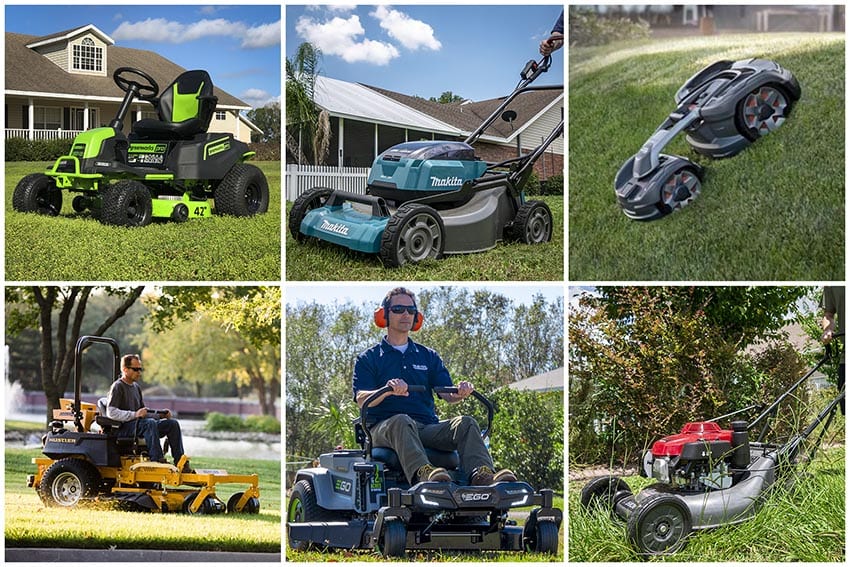A Guide to Design Types, Their Pros and Cons, and Cost Considerations
Lawn care is a chore, and there’s no way around it, but with a new lawn mower, it can be a much more enjoyable experience. This guide covers the different kinds of lawn mowers and explains how to choose the best type of lawn mower for your yard.
Types of Lawn Mowers: Exploring Your Options
There are many different types of lawn mowers, and it can be hard to decide which one is best for your lawn. Learning about the most popular types of lawn mowers and the advantages and disadvantages of each can make shopping for a lawn mower easier.
To start, most mowers are either “walk-behind” designs or riding lawn mowers, and many different types fall into each category. There are also robotic lawn mowers available that make lawn mowing even easier.
Push Lawn Mowers
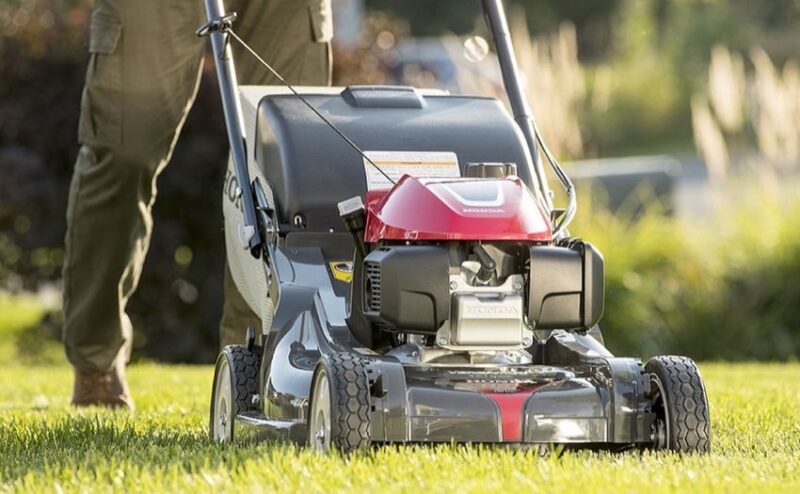
When most people think of a lawn mower, they picture a push mower. A push lawn mower is a type of lawn mower that the user pushes and operates manually.
They can run on electricity, gasoline, battery, or manual power.
Get the most out of the best type of lawn mower for you. Read OPE‘s guide to mowing like a Pro!
Pros of Push Lawn Mowers
All types of push lawn mowers have several advantages and are the perfect size for lawns under a ¼ acre. They are easy to use and significantly less expensive than riding lawn mowers.
It’s also easier to move obstacles out of your way when you’re using a push mower.
Here are the advantages of the different drive types of push lawn mowers:
| Power Source | Advantages |
| Reel push mower (manual) | Doesn’t require a power source and is easy to maintain |
| Gas-powered push mower | Light, inexpensive, and can be taken anywhere |
| Electric-powered push mower | Easy to plug in and use |
| Battery-powered push mower | Not hindered by a cord, some models come with two batteries, so you can charge one while you’re using the other |
Cons of Push Lawn Mowers
One of the biggest drawbacks of push mowers is it takes longer to mow, so they aren’t great for large lawns. Most push lawn mowers don’t mow through thick grass as easily as large riding lawn mowers, which can be tiring.
Here are the disadvantages of the different drive types of push lawn mowers:
| Power Source | Disadvantages |
| Reel push mower (manual) | Won’t go over sticks, is hard to operate on hills and uneven ground, and won’t cut tall, thick grass |
| Gas-powered push mower | Gas fumes may be bothersome, and they require more maintenance |
| Electric-powered push mower | The cord gets in the way, and you have to be careful not to run over it |
| Battery-powered push mower | Battery life is only about one hour and replacement batteries are expensive |
Self-Propelled Lawn Mowers
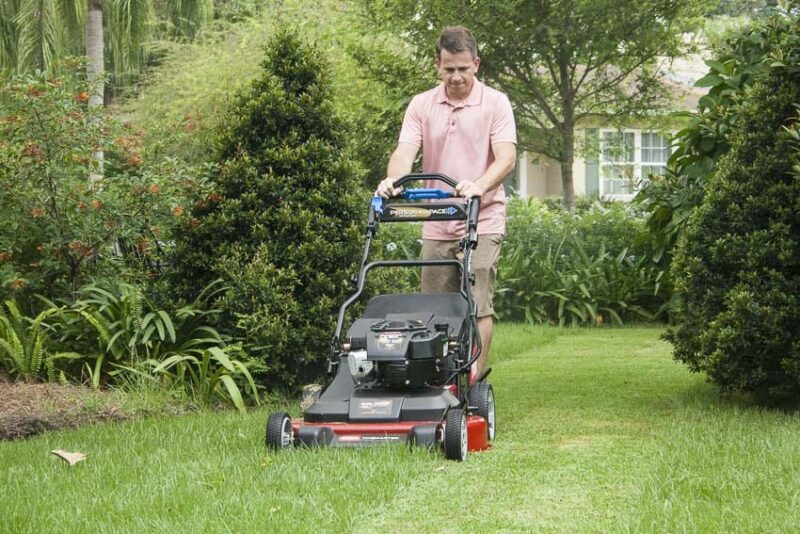
Similar to cars, self-propelled lawn mowers can be front-wheel drive (FWD), rear-wheel drive (RWD), or all-wheel drive (AWD). They propel themselves forward when you start them and put them in gear.
Pros of Self-Propelled Lawn Mowers
Self-propelled lawn mowers can make mowing your lawn easier. They also make it easier to mow hillsides and slopes.
Here are the advantages of the three main types of self-propelled lawn mowers:
| Drive Type | Advantages |
| FWD self-propelled mower | Better for small, level lawns and easier to steer than other types of self-propelled mowers |
| RWD self-propelled mower | Perfect for slopes and tough terrain when you mow back and forth rather than up and down |
| AWD self-propelled mower | Increased speed and power over other types of walk-behind mowers |
Cons of Self-Propelled Lawn Mowers
All types of self-propelled lawn mowers are more expensive than standard push mowers. Furthermore, they are heavier, which makes them difficult to transport, should the need arise. Likewise, they don’t work well with small lawns because they are difficult to turn.
Here are the disadvantages of the three main types of self-propelled lawn mowers:
| Drive Type | Disadvantages |
| FWD self-propelled mower | Doesn’t perform well on slopes |
| RWD self-propelled mower | Difficult to turn, and driving backward is hard without a reverse gear |
| AWD self-propelled mower | Not as easy to maneuver as FWD mowers |
Riding Lawn Mowers
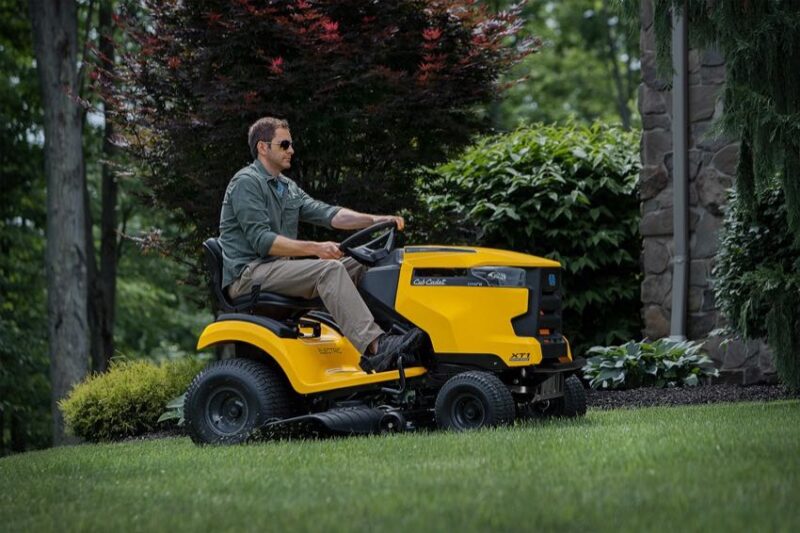
When you have a lawn that’s over a ¼ acre, a riding lawn mower is the best choice.
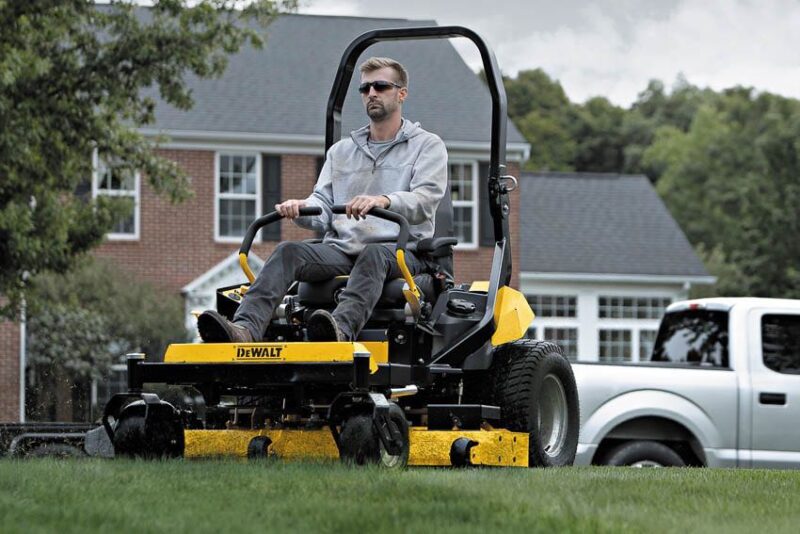
There are many types of riding lawn mowers, however, they easily go under one of the following design labels lawn tractors, zero-turn mowers, and rear-engine mowers. Commercial lawn mowers typically fall within this category.
Pros of Riding Lawn Mowers
There are several advantages to choosing a riding mower.
For example, they are more comfortable and convenient and will save you time and energy. Plus, you can use them with various attachments to do more than mow your lawn.
Here are the advantages of the three main types of riding lawn mowers:
| Type of Riding Mower | Advantages |
| Lawn tractor | Good for large lawns, available in different transmission types, and less expensive than other types of riding mowers |
| Zero-turn mower | The best mower in terms of maneuverability and steering power, available with ultra-wide decks to make mowing faster than ever |
| Rear engine mower | Good for mid-sized lawns, less expensive |
Cons of Riding Lawn Mowers
The biggest drawback of a riding lawn mower is the initial expense, and repairs and maintenance are also more expensive with riding lawn mowers.
Here are the disadvantages of the three main types of riding lawn mowers:
| Type of Riding Mower | Disadvantages |
| Lawn tractor | Not easy to maneuver and won’t turn sharp corners |
| Zero-turn mower | More expensive than other types of riding mowers |
| Rear engine mower | Has a smaller cutting width than other types of riding mowers |
Robotic Lawn Mowers
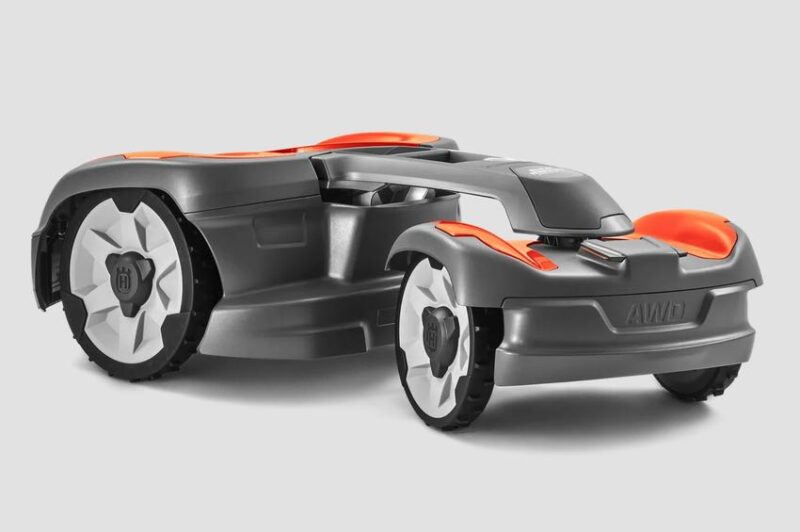
The first robotic lawn mower came out in 1969, called the MowBot. It was a precursor to modern household robotic appliances like the Roomba .
Today, robotic mowers operate based on satellite location or boundary wire systems and are accurate within 2-3 centimeters.
Pros of Robotic Lawn Mowers
The main advantage of robotic lawn mowers is that they take care of your mowing independently. They are quieter, cost less to operate, and their cutting pattern leaves a neat and tidy lawn.
Since they mow more frequently, they can leave the grass clippings for mulch, which benefits the soil by putting nutrients back into your lawn. They are great for seniors and disabled people, and they will even mow your lawn while you’re on vacation.
Cons of Robotic Lawn Mowers
If robotic lawn mowers sound like a dream come true, they are, but with some caveats.
They come with a high price tag, and you must keep your lawn free of obstacles, like kids’ toys. Installation can be complex, and they aren’t well-suited to mowing on hillsides and steep slopes.
They also work best on simple yards, and they don’t do the best job of trimming the edges.
Cost Ranges of Different Types of Lawn Mowers

Most people have to consider a budget when purchasing a lawn mower, but it’s important to understand that cheaper isn’t always better. It’s best to balance the pros and cons of each type of mower with the cost.
Factors Influencing Cost
There are several factors that affect the cost of lawn mowers. When you’re comparing different types of mowers, consider these factors:
Power sources
Corded electric models are usually the least expensive, followed by gas-powered models, and battery-powered lawn mowers, which are the most expensive.
Cutting width
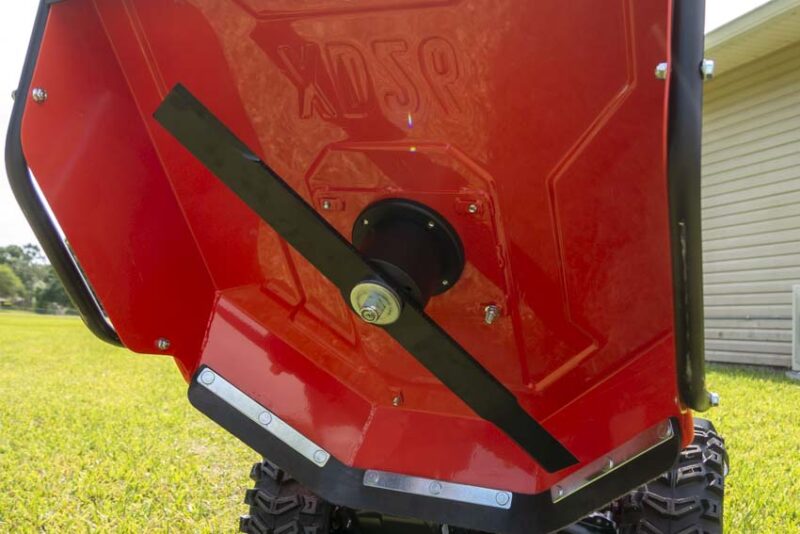
The width of the mower deck is an important factor because it determines how fast you can mow your lawn.
- Walk-behind lawn mowers–14” to 22”
- Riding lawn mowers–30” to 61”
Fuel and battery capacity
A larger fuel tank or an extra battery will make mowing less of a hassle, but it will cost more.
Speed
Most riding lawn mowers can go about 4 to 9 miles per hour, and zero-turn mowers are even faster. Be aware that going too fast can compromise the cutting performance of your mower.
For commercial purposes, there are several different types of zero-turn lawn mowers that provide the speed necessary to keep up with large areas.
Price Comparison of Lawn Mower Types
Here are the average price ranges for different types of lawn mowers. Keep in mind the advantages and disadvantages of each type of lawn mower to find the best one for your yard, lifestyle, and budget.
Push Lawn Mowers Price Range
Push lawn mowers remain one of the most popular choices for homeowners, and they are the most affordable.
| Type of Lawn Mower | Average Cost | Price Range |
| Reel push mower (manual) | $115 | $80 to $210 |
| Gas-powered push mower | $320 | $220 to $815 |
| Electric-powered push mower | $260 | $85 to $620 |
| Battery-powered push mower | $350 | $250 to $850 |
Self-Propelled Lawn Mowers Cost Range
One of the biggest factors that affect the cost of self-propelled (SP) mowers is their power source. Many self-propelled lawn mowers are powered by gas because it takes a lot of energy to drive the wheels.
| Type of Lawn Mower | Average Cost | Price Range |
| Gas-powered SP mower | $630 | $270 to $3,310 |
| Corded electric SP mower | $675 | $180 to $1,570 |
| Battery-powered SP mower | $700 | $400 to $1,200 |
Riding Lawn Mowers Price Range
Within each category of riding lawn mowers, there are many factors that affect the cost, including the size of the deck, the type of transmission, and the brand. Fortunately, that makes it easier for people on tight budgets to find a riding lawn mower in their price range.
| Zero-turn Mower | Average Cost | Price Range |
| Lawn tractor | $3,500 | $2,000 to $5,500 |
| Zero turn mower | $5,000 | $3,000 to $7,500 |
| Rear-engine mower | $3,200 | $1,800 to $5,500 |
Robotic Lawn Mowers Cost Range
When choosing the right robotic lawn mower for your yard, consider the factors influencing the cost.
Large yards need a robotic mower with a longer battery life. By paying more, you can get extra features like edge-cutting, traction wheels for slopes, and additional charging stations for different zones.
| Type of Lawn Mower | Average Cost | Price Range |
| Robotic lawn mower | $1,320 | $630 to $5,670 |
Additional Costs to Consider
It’s also important to consider the following costs when comparing lawn mower prices.
- Accessories and attachments
- Maintenance and repairs
- Replacement parts and blades
- Fuel and electricity costs
- Storage solutions and protective covers
Choosing the Best Lawn Mower for Your Lawn and Needs
There’s a lot to cover when choosing the best lawn mower for your yard. To purchase the best mower for your personal needs, take the size of your lawn and the terrain of your yard into account, and balance your budget with the features of the lawn mower you’re considering.
You should also consider your lawn care requirements. If you’re growing a clover lawn and only need to mow your yard a few times a year, you probably don’t need to spend as much as you do if you’re mowing every week.
Types of Lawn Mowers FAQs
Which type of lawn mower is best for small yards?
A battery-powered walk-behind mower is ideal for a small yard because you can mow quickly, and you’ll save on fuel costs.
What type of lawn mower is ideal for large properties or uneven terrain?
Riding mowers are ideal for large properties, but they aren’t all suitable for uneven terrain. Front-engine riding lawn mowers are usually the best choice for uneven ground. However, it’s best to use caution on sloped areas, and you should use a walk-behind mower or weed eater on steep hillsides.
How do I maintain and care for my lawn mower?

The best maintenance routines for your lawn mower depend on the type of mower you have, but all mowers benefit from regular blade sharpening. Sharp blades will help your lawn stay lush and green.
How often should I replace my lawn mower blades?
For most homeowners, the annual replacement of your lawn mower blades is adequate. Sharpening twice per season or after about 25 hours of use is recommended.
Are electric or battery-powered lawn mowers worth the investment?
The most popular type of lawn mower is an electric-powered lawn mower, and battery-powered mowers are right behind them. They are simple to operate and maintain, making them a worthwhile investment for most homeowners.

